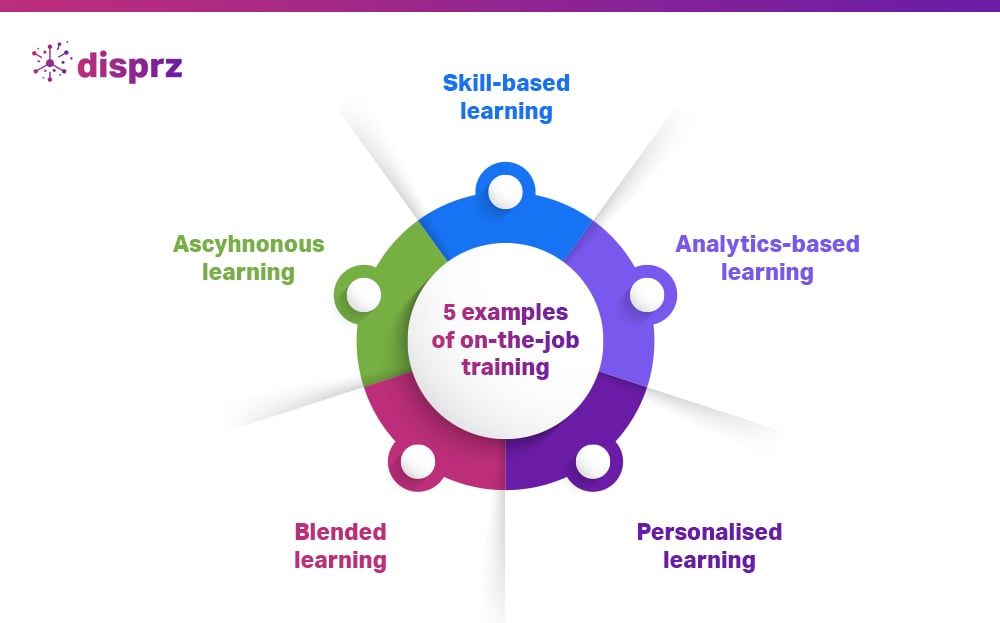
6 min read
• 25 Apr 2024
5 Types Of On-the-job Training That Drive Better Results
The right OJT approach can make a big difference. Here are a few types of on-the-job training that can help you create effective learning programs.
-
eBookEmployee Upskilling - A Detailed Blueprint For Building A Skills-Driven Learning Culture
So, you abandoned the traditional training setup and hopped on the on-the-job training (OJT) bandwagon due to its rising popularity. The real question is, have you seen an ROI from infusing learning and development into your employees’ workday?
If your answer is no, did you take a step back and wonder why your OJT program was not successful?
5 Types of On-the-job Training for Your Employees
We know that just-in-time learning is an effective way of training the workforce. However, how you present on-the-job training also makes a big difference. If your OJT program isn’t impactful and relevant to your employees, they will refrain from investing their valuable time into it during work hours.
Given the importance of on-the-job training, it is best not to waste your precious time on OJT approaches that are not working. Read on for a few examples of on-the-job training that can help you create effective learning programs that convert into workplace performance.

1. Skill-based learning
Most on-the-job training is confined to providing generic knowledge or policy/product-based information. This is why it often fails to drive the intended impact.
It is imperative to give employees strong reasons for balancing learning with work. Employees would be more interested in learning programs that help them reach their full potential and meet their career goals.
Skill-based learning seamlessly blends into on-the-job training. Developing necessary skills through on-the-job training can positively impact employee performance. And PWC’s research found 77% of employees are ready to learn new skills.
For making this OJT approach successful, it is imperative to identify and benchmark the necessary skills for each role. Modern technology like a Learning Experience Platform(LXP) can help you identify the trending skills for different employee roles and track the proficiency level to measure the skill score. Based on the skill level, you can assign relevant courses to address the improvement areas and boost the efficiency of the employee.
2. Asynchronous learning
Asynchronous learning is a flexible learning method that doesn’t limit employees to any stipulated time frame for skilling.
With this type of on-the-job training, employees can learn and grow at their own pace. They aren’t overwhelmed with a large pool of information at one time. Employees can easily access the learning material designed by the L&D professionals at any hour of the day.
However, because it is asynchronous, it doesn’t need to happen in silos. Employees can collaborate with their peers through social learning and ensure timely knowledge sharing. They can post queries in the social group whenever they are stuck and get them resolved instantaneously.
3. Blended learning
Blended learning combines the benefit of intent-based digital learning and instructor-led training. Employees can attend a learning session with their teams on common topics and then enroll in online courses at their preferred time to enhance their unique capabilities.
They can also learn the fundamentals of specific subjects before joining the classroom modules for in-depth discussion. In a nutshell, blended learning smartly merges asynchronous and synchronous learning that helps cover everything from product-led training to skill-driven learning to drum up interest and learning adoption.
4. Personalized learning
Employees are more likely to engage in learning material that would add value to their daily tasks. In the modern world of “Netflix” and “Amazon”, where employees get personalized recommendations, they expect the same “just for me” experiences in their learning journey. Therefore, it is crucial to create personalized learning pathways based on individual interests and skill gaps for your on-the-job training program.
When learning programs are aligned with employees’ goals and career aspirations, they take ownership of their skill development and put in sincere efforts to improve their skills. For example, one of Hong Kong’s multinational finance and insurance companies established a continuous learning culture with AI-driven content recommendations and experienced 29% improved sales results through a structured sales enablement process.
Read the full case study on how this Hong kong based firm personalized learning and improved productivity with an AI-powered LXP.
5. Analytics-based learning
Curating and designing on-the-job training isn’t a walk in the park. It consumes a considerable amount of time and effort. So instead of just developing learning content, it is essential to pause and evaluate if the employees benefit from the learning content.
Assessments and learning analytics can help you gauge the effectiveness of your on-the-job training. Based on skill gap assessment, you can provide and take feedback from the employees to improve on-the-job training.
A complete skilling suite, like Disprz, not only enables you to create impactful on-the-job learning journeys but also helps you dig deeper into learning analytics. You can slice and dice learning data as per your company’s requirements and leverage it to level up your OJT programs.
Final thoughts
You have just seen there are various ways to conduct effective on-the-job training programs that can drive results. However, to implement these various on-the-job examples, it is essential to have the right technology in place.
Disprz LXP enables you to do all of the above from one platform. This advanced learning platform focuses on complete skill development, from skill identification to skill building. You can effortlessly blend asynchronous and synchronous learning without leaving the platform. It empowers you to track skilling analytics with business-linked dashboards that are tied to company goals. Moreover, through periodic assessments and feedback, managers can assess current skill levels and guide the employees on the right path.

About the author

Debashree Patnaik
Debashree is a seasoned content strategist at Disprz.ai, specializing in enterprise learning and skilling. With diverse experience in B2B and B2C sectors, including ed tech, she leads the creation of our Purple papers, driving thought leadership. Her focus on generative AI, skilling, and learning reflects her commitment to innovation. With over 6 years of content management expertise, Debashree holds a degree in Aeronautical Engineering and seamlessly combines technical knowledge with compelling storytelling to inspire change and drive engagement.
More Resources
4 min read
• 15 Apr 2024
Unlocking the Power of Managerial Engagement in Talent Development
4 min read
• 09 Apr 2024
Nurturing Excellence in Building Leadership Pipelines
Sign up to get free resources and stay up to date with Disprz!
Discover how Disprz can align learning and upskilling with your desired business outcomes.





